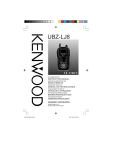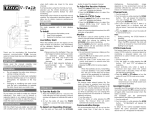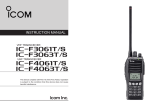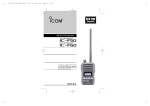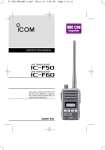Download Kenwood Electronics PMR446 Consumer FM Transceiver
Transcript
FM TRANSCEIVER UBZ-LJ8 INSTRUCTION MANUAL CONTENTS INTRODUCTION ....................................................................... 1 SUPPLIED ACCESSORIES .......................................................... 1 PRECAUTIONS ........................................................................ 2 ORIENTATION .......................................................................... 3 CONTROL FUNCTIONS ............................................................. 3 DISPLAY ................................................................................ 4 PREPARATION ........................................................................ 5 INSTALLING/ REMOVING BATTERIES ............................................ 5 SETTING THE ANTENNA ........................................................... 6 INSTALLING/ REMOVING THE BELT CLIP ...................................... 7 INSTALLING/ REMOVING OPTIONAL ACCESSORIES ........................ 8 GETTING STARTED ................................................................ 9 GROUP MODE ...................................................................... 10 SECRET MODE ..................................................................... 11 MENU SETTINGS .................................................................. 12 BEEP TONES ....................................................................... 12 BATTERY INDICATOR/ BATTERY TYPE ........................................ 13 AUTO POWER OFF (APO) .................................................... 14 AUTO CHANNEL SELECT ........................................................ 14 VOICE ACTIVATED CONTROL (VOX) ........................................ 16 CALLING ALERT TONES ......................................................... 18 SQUELCH ............................................................................ 19 OPERATING FEATURES ....................................................... 20 KEY LOCK ........................................................................... 20 LAMP .................................................................................. 20 TRANSMIT POWER SAVER ...................................................... 21 BATTERY SAVER ................................................................... 21 LOUDNESS ........................................................................... 22 RESETTING THE TRANCEIVER .......................................... 23 OPTIONAL ACCESSORIES .................................................. 24 SMC-34 SPEAKER-MICROPHONE ...................................... 25 MONITOR ............................................................................ 25 ADDITIONAL FUNCTIONS ........................................................ 25 SPECIFICATIONS .................................................................. 26 TRANSCEIVER SPECIFICATIONS ............................................... 26 CHANNEL FREQUENCY CHART ................................................ 26 GROUP MODE NUMBERS ....................................................... 27 TK-3101 / UBZ-LJ8 COMPATIBILITIES .................................. 27 TROUBLESHOOTING GUIDE ............................................... 28 INTRODUCTION Thank you for purchasing this KENWOOD Private Mobile Radio 446 (PMR446). This KENWOOD product is a precision device. Treat it with care, and you will enjoy years of reliable operation. PMR446 refers to personal short range Private Mobile Radios for family and friends to keep in touch without the need for a licence, radio knowledge, or monthly charges. Your KENWOOD PMR446 is called a “transceiver”, meaning transmitter and receiver. You can choose from eight preset channels to communicate with others. For your convenience, Automatic Squelch quiets your transceiver when you are not receiving calls and Group Mode keeps your transceiver quiet except for calls you want to hear. For your privacy, Secret Mode encrypts your messages so you can talk with your group members without having others listen in on your conversation. Your transceiver provides safety and convenience almost anywhere. The talk range depends on your location; you’ll get maximum distance of up to approximately 3.2 km (2 miles) in open areas, less in buildings and vehicles. Information KENWOOD is on the web: http://www.kenwood.com/ SUPPLIED ACCESSORIES Carefully unpack the transceiver. Make sure the following items are included in your kit before discarding the packing material: • Transceiver • Belt clip • Instruction manual • Warranty card 1 PRECAUTIONS • Refer service to qualified technicians only. Do not modify or attempt to adjust the transceiver for any reason. • Do not expose the transceiver to long periods of direct sunlight, nor place it close to heating appliances. • Do not place the transceiver in excessively dusty, humid, and/ or wet areas, nor on unstable surfaces. • Avoid extremes in exposure to weather, heat, and cold. This transceiver can be used in mild weather conditions, but it is not waterproof. • Turn OFF your transceiver while taking on fuel or while parked in gasoline service stations. • Do not operate your transceiver or charge your battery pack in an explosive atmosphere (gases, dust, fumes, etc.). • If an abnormal odor or smoke is detected coming from the transceiver, immediately switch OFF the power and remove the batteries. Contact your KENWOOD dealer. 2 ORIENTATION Antenna VOL control Display PTT switch SP/MIC jacks ▲ key Power switch ▼ key key Microphone Speaker CONTROL FUNCTIONS PTT (Push-to Talk) switch: Press this switch then speak into the microphone to make a call. Release the switch to receive. ▲ key: Press to increase the channel or group mode number, and to turn selected functions ON or OFF. ▼ key: Press to decrease the channel or group mode number, and to turn selected functions ON or OFF. VOL control: Rotate to adjust the volume level. Power switch: Press and hold to turn the transceiver power ON or OFF. With the power ON, press momentarily to enter the Loud Function setting. key: Press momentarily to enter the Group Mode setting. Press momentarily again to enter the Secret Mode setting. Press a third time to return to normal. Press and hold to lock the transceiver controls. 3 DISPLAY Appears when the transceiver controls have been locked (page 20). Displays the remaining battery power (page 13). Appears when the Secret Mode has been activated (page 11). appears and blinks when Secret Mode can be turned ON or OFF (page 11). Appears when the Auto Power Off function has been activated (page 14). Appears while scanning (page 14). Appears while the VOX function is in use (page 16). Appears while transmitting. Appears while receiving a signal or while the squelch is deactivated (page 19). Appears when the internal audio amplifier has been activated (page 22). Appears while setting the beep function ON or OFF (page 12). Displays the current channel number (1 to 8). Displays the current Group Mode number (1 to 38) or OFF (“OF”) (page 10). appears and blinks when the Group Mode number can be selected (page 10). 4 PREPARATION INSTALLING/ REMOVING BATTERIES This transceiver requires 3 LR6 (AA) batteries. Use high quality alkaline batteries to enjoy longer periods of battery life. You can also use an optional UPB-1 NiCd battery pack. When using an optional battery pack, be sure to set the battery indicator type to battery pack, from its default setting of alkaline batteries. Refer to page 13 for details on how to set the indicator type. Average alkaline battery life: 24 hours Average battery pack life: 12 hours Average times are calculated using 10% transmit time, 10% receive time, and 80% standby time Note: Before installing/ removing batteries, you must rotate the antenna out of the way (page 6). 1 Release the battery cover lock, then slide the cover away from the transceiver. Battery cover Lock 2 Insert (or remove) 3 LR6 (AA) batteries or the optional UPB-1 NiCd battery pack. • Mate the battery polarities with those marked on the battery compartment. • When removing the battery pack, pull on the ribbon that is attached to the pack to dislodge the pack from the battery compartment. 5 Battery installation Battery pack installation Label Contacts Ribbon 3 Align the battery cover tabs with the slots on the transceiver, hold the cover in place, then latch it with the battery cover lock. Note: ◆ Do not mix old and new batteries or batteries of different types. ◆ When you do not use the transceiver for an extended period of time, remove the batteries from the transceiver. SETTING THE ANTENNA Before using the transceiver, be sure to raise the antenna. 6 INSTALLING/ REMOVING THE BELT CLIP 1 To install the belt clip, align the clip with the guides on the rear of the transceiver, then slide the belt clip up until it latches in place. 2 To remove the belt clip, press the locking latch in then slide the belt clip down before pulling it away from the transceiver. Locking latch 7 INSTALLING/ REMOVING OPTIONAL ACCESSORIES Note: Always switch OFF the transceiver power when installing or removing the optional accessories. The following accessories can be used with this transceiver: • EMC-3 Clip Microphone and Earphone • HMC-3 VOX/PTT Headset • KHS-21 Headset • SMC-32 Speaker-Microphone • SMC-33 Speaker-Microphone • SMC-34 Speaker-Microphone To install these accessories: 1 Open the SP/MIC tabs on the side of the transceiver. 2 Insert the accessory’s plugs into the SP/MIC jacks. 3 When you remove the accessory from the transceiver, be sure to cover the SP/MIC jacks with the attached tabs in order to keep dust and dirt away from the contacts. Note: ◆ Refer to the accessory instruction manuals for detailed instructions on each of the accessories. ◆ The transceiver is not water resistant while using accessories. 8 GETTING STARTED q Switch the Power ON by pressing and holding the switch for approximately 1 second. • A confirmation tone sounds. To switch the transceiver power OFF, press and hold the switch again for 1 second. w Adjust the Volume by rotating the VOL control. • Clockwise increases the volume and counterclockwise decreases the volume. e Select a Channel from 1 to 8 by pressing the ▲ and ▼ keys. • A confirmation tone sounds each time you press a key. • When you receive a call on your selected channel, you will hear audio from the speaker and the busy icon will appear. • To use a Group Mode number, refer to “GROUP MODE” on page 10. r Make a Call: 1 Press and hold the PTT switch, then speak into the microphone to transmit. • The transmit icon will appear. • For best sound quality, speak into the microphone in your normal speaking voice while holding the microphone approximately 3 to 4 cm (1.5 inches) from your lips. 2 Release the PTT switch when you have finished speaking. 9 GROUP MODE Group Mode is a function which allows you to reject signals from undesired parties that are using the same channel as you. You will hear audio from the speaker only when you receive a signal that matches your Group Mode number. Likewise, when you transmit on a channel set up with a Group Mode number, the receiving station must have a matching Group Mode number in order to hear your call. You can select a Group Mode number from 1 to 38 (or OFF). After changing your Group Mode number, confirm that the other members in your group have selected the same number. 1 Press the key. • The current setting appears with a flashing arrow. 2 Press the ▲ or ▼ key to select your desired value. • The values range from 1 to 38. “OF” means you have selected no Group Mode number. Refer to page 27 for the actual Group Mode numbers. 3 Press the setting. 10 key two times to confirm the SECRET MODE Whereas the Group Mode function (page 10) allows you to ignore unwanted calls, Secret Mode allows you to hold a conversation in complete privacy. When activated, any other party listening in on your channel will be unable to understand your conversation. The transceiver scrambles your voice so that anybody listening in on your conversation will not be able to understand what you are saying. In order for members of your own group to understand your call while you are using Secret Mode, all other members must also activate Secret Mode on their transceivers. This scrambles everybody’s voice while transmitting and unscrambles the voice message on your own transceiver when you receive the message. Note: In order to enter Secret Mode, you must also select a Group Mode number. If you have not selected a Group Mode number, do so before following the instructions given below. 1 Press the key two times. • The privacy icon appears with a flashing arrow. 2 Press the ▲ or ▼ key to turn Secret Mode ON or OFF. • An image appears in the privacy box when Secret Mode is ON. 3 Press the setting. key again to confirm the 11 MENU SETTINGS Your transceiver has a hidden setting menu which allows you to adjust a variety of features to your desired settings. To enter Menu Setting: 1 Press and hold the ▲ key while turning the transceiver power ON. 2 To view the various settings, press the ▲ or ▼ key. Following are a list of the settings available: • • • • • • Beep: ON/ OFF Battery Type: Alkaline Batteries/ UPB-1 Battery Pack APO (Auto Power Off): ON/ OFF Auto Channel Select: Remove/ Add VOX (Voice Activated Control) Gain Level: OFF/ 1/ 2/ 3 VOX Delay Time (Only available when VOX Gain Level is not OFF. Refer to page 17.): 0.5/ 1.0/ 2.0/ 3.0 seconds • Calling Alert Tone: 1 ~ 10 • Squelch: ON/ OFF 3 Refer to the appropriate sections below for details of adjusting each setting. BEEP TONES You can turn the transceiver beep tones ON or OFF, as desired. 1 Enter the Menu Settings (above) and press the ▲ or ▼ key until you reach the “BEEP” display. 2 key to turn the beep tones Press the ON ( ) or OFF ( ). 12 3 Press the PTT switch or turn the transceiver power OFF to confirm your setting. BATTERY INDICATOR/ BATTERY TYPE The battery indicator on the display lets you know approximately how much battery life is remaining. When the battery voltage becomes too low while transmitting, the transceiver stops transmitting and a tone sounds until you release the PTT switch. Recharge or replace the battery pack at this time. High battery power Medium battery power Low battery power Time to replace the batteries or recharge the battery pack Depending on the type of batteries you are using in the transceiver, adjust the battery type to match. The battery indicator can only accurately read out the remaining battery power if this value is set correctly. An incorrect setting will result in an inaccurate battery power readout on the display. 1 Enter the Menu Settings (page 12) and press the ▲ or ▼ key until you reach the “ ” display. 2 Press the key to set the value to alkaline batteries ( ) or to the optional UPB-1 battery pack ( ). • You must set this menu each time the battery type is changed. 3 Press the PTT switch or turn the transceiver power OFF to confirm your setting. 13 AUTO POWER OFF (APO) Auto Power Off is useful when you unintentionally leave the transceiver power ON. This function saves battery consumption. After two hours elapse with no controls adjusted or activated and no calls received, APO turns the transceiver power OFF. One minute before power is turned OFF, a warning tone sounds (even if the beep tone has been turned OFF). 1 Enter the Menu Settings (page 12) and press the ▲ or ▼ key until you reach the “APO” display. 2 key to turn the Auto Power Press the Off function ON ( ) or OFF ( ). 3 Press the PTT switch or turn the transceiver power OFF to confirm your setting. • If you have turned the APO function ON, the APO icon appears on the display. AUTO CHANNEL SELECT Auto Channel Select allows you to scan the transceiver channels to search for a signal. When the transceiver verifies a signal on a channel, it proceeds to check whether or not its Group Mode number matches that which is set up on your transceiver. (Auto Channel Select will not operate if no Group Mode number is selected.) If the Group Mode number matches, the transceiver stops at the channel and opens the squelch so you can listen to the call. If the Group Mode number does not match, the call is ignored and scanning continues. 14 Before you can use the Auto Channel Select function, ensure that it is activated. You can add or remove this function to/ from your transceiver using the Menu Settings: 1 Enter the Menu Settings (page 12) and press the ▲ or ▼ key until you reach the “SCAN” display. 2 key to remove Auto Channel Press the Select from your transceiver ( ) or add it to your transceiver ( ). 3 Press the PTT switch or turn the transceiver power OFF to confirm your setting. When you have added Auto Channel Select to your transceiver, you can then operate scan while using the transceiver. To begin scanning: 1 Press and hold the ▲ key for approximately 1 second. • The SCAN icon appears on the display. 2 When a signal is detected and the Group Mode number matches, the channel number blinks. 3 When the signal is no longer present, the transceiver waits for 10 seconds before scanning continues. • If a new signal appears before the 10 seconds elapse, the transceiver will remain on the channel until the new signal is no longer present. 15 4 To end the scan at any time, press the ▲, ▼, or key. VOICE ACTIVATED CONTROL (VOX) Using the VOX feature, you can operate the transceiver hands-free. For best operating conditions, we recommend you use an optional headset with both an ear piece and a microphone on a boom that rests in front of your mouth. With VOX activated, your voice level will determine when the transceiver transmits. Because of this, you must take care that the ambient noise around you is not so loud that it causes the transceiver to transmit. Due to the automatic switching between transmission and reception, we recommend you set the VOX gain such that it will not activate transmission when in an area with excessive ambient noise. Before VOX will operate, you must set a VOX Gain Level: 1 Enter the Menu Settings (page 12) and press the ▲ or ▼ key until you reach the “VOX” display. 2 key to set the VOX Gain Press the Level ( ) from 1 to 3, where 3 is the most sensitive setting, or OFF ( ). 3 Press the PTT switch or turn the transceiver power OFF to confirm your setting. • If you have turned the VOX function ON by selecting a VOX Gain Level other than OFF ( ), the VOX icon appears on the display. 16 When operating VOX, if you find that the transceiver returns to receive mode too quickly after you stop speaking, the end of your message may not be transmitted. To avoid this, select an appropriate delay time to allow your entire message to be transmitted. However, do not make the delay overly long. 1 Enter the Menu Settings (page 12) and press the ▲ or ▼ key until you reach the ” display. “VOX • This menu is only available if the VOX Gain Level has been set to any value other than OFF ( ). 2 Press the key to set the VOX Delay Time ( ) from 0.5 to 3.0 seconds. 3 Press the PTT switch or turn the transceiver power OFF to confirm your setting. When you have activated the VOX function and selected an appropriate Gain Level and Delay Time, you can then operate the transceiver hands-free. To use VOX: 1 To transmit, simply speak into the headset microphone. • You do not need to press the PTT switch; the transceiver automatically detects your voice and begins transmitting. 2 To stop transmitting, stop speaking. • Transmission will continue momentarily after you stop speaking. You can select the delay time as described above. 3 To exit VOX operation, set the VOX gain level (page 16) to OFF ( ). 17 CALLING ALERT TONES Calling Alert Tones are used to identify yourself to your party members. You can set up a Calling Alert Tone to one of ten types. If each party member uses a different tone, it is easy to know who is making the call. To select your Calling Alert Tone: 1 Enter the Menu Settings (page 12) and press the ▲ or ▼ key until you reach the “ ” (Calling Tone) display. 2 Press the key. • The current Calling Alert Tone number blinks and the Calling Alert Tone sounds. 3 Press the ▲ or ▼ key to select your desired Calling Alert Tone, from 1 to 10. • The selected Calling Alert Tone sounds each time you press the ▲ or ▼ key. 4 Press the PTT switch or turn the transceiver power OFF to confirm your setting. To use the Calling Alert Tone: 1 Press the PTT switch to transmit, as normal. 2 Before speaking into the microphone, momentarily press the ▲ key. • Your Calling Alert Tone is transmitted to your party members. 3 Continue your call as normal. 18 SQUELCH When no signals are present, the squelch on the transceiver automatically mutes the speaker so you will not hear background noise. You can however, deactivate the squelch. This feature is useful for a variety of reasons: • It allows you to confirm the channel activity so that you don’t make a call while another party is using the same channel. • It allows you to adjust the volume level without having to wait for a call. • When receiving a call that is intermittent due to a weak signal, disabling the squelch will allow you to listen to the call without it continuously cutting out. 1 Enter the Menu Settings (page 12) and press the ▲ or ▼ key until you reach the “ ” (Squelch) display. 2 Press the key to turn the squelch function ON ( ) or OFF ( ). 3 Press the PTT switch to confirm your setting. • If you have turned the squelch function OFF, the busy icon appears on the display. Note: Turning the transceiver power OFF will reset the squelch to its default setting. When the transceiver is turned back ON, squelch is also automatically turned ON. 19 OPERATING FEATURES KEY LOCK You can lock the ▲, ▼, and keys to prevent accidentally changing the channel and channel settings. Additionally, while the transceiver is locked, you cannot enter the Menu Settings (page 12). key for 1 second to Press and hold the lock or unlock the transceiver keys. • The icon appears on the display when the transceiver keys are locked. No icon appears when they are unlocked. While the key lock function is active, you can still perform the following functions: • Power ON/OFF • Volume adjustment • Receive/ transmit • Monitor • Calling Alert Tones • Full reset LAMP The lamp is used to illuminate the Liquid Crystal Display. Each time a key is pressed (other than the PTT switch or the VOL control), the lamp turns ON and remains on for 5 seconds. If you press a key while the lamp is already on, the lamp timer will reset the 5 second countdown. Note: There is no key to turn the lamp OFF. It will turn OFF automatically. 20 TRANSMIT POWER SAVER The purpose of the Transmit Power Saver is to prevent you from transmitting continuously for a long time. This function is useful, for example, when you accidentally keep the PTT switch pressed. If you continuously transmit for 3 minutes, the transceiver will stop transmitting and a tone will sound. To stop the tone, release the PTT switch. You can press the PTT switch again to resume transmitting. The 3 minute timer cannot be adjusted. This transceiver is also equipped with a visual warning, 30 seconds before the Transmit Power Saver time expires, and a pre-alert tone which sounds 10 seconds before the time expires. This will allow you to finish your message before the transceiver automatically stops transmitting. Thirty seconds before the time expires, the number 30 will appear and blink on the display in place of your Group Mode number. Ten seconds before the time expires, a tone will sound. BATTERY SAVER This transceiver has been designed to give you the most out of your battery power. The battery saver decreases the amount of power used when a signal is not being received and no operations are being performed. While using the transceiver, the battery saver will automatically switch ON after 5 seconds have elapsed with no operations or received calls. Operating the transceiver or receiving a call will switch the feature OFF until 5 seconds of non-operation occurs again. 21 LOUDNESS This transceiver has a built in booster amplifier. You can control the volume level by rotating the VOL control. However, if you are in an environment with excessive ambient noise, you may find that it is difficult to hear the audio from the transceiver, even with the volume increased to its maximum value. In such a case, you can switch the internal booster amplifier ON to further increase the volume level. switch to enter 1 Momentarily press the the Loudness setting. 2 Press the ▲ or ▼ key to turn the booster amplifier ON ( ) or OFF ( ). 3 Press the switch or the confirm your setting. key to • If you have turned the booster amplifier function ON, the LOUD icon appears on the display. Note: ◆ The Loudness function will not operate if you are using an optional speaker-microphone. ◆ The booster amplifier uses more battery power. Thus, while using the Loudness function, the battery life will become shorter. 22 RESETTING THE TRANSCEIVER At some point in time, you may desire to reset the transceiver settings to their default values. The default values of all the menus and channel settings are listed in the table below. To reset the transceiver: 1 Turn the transceiver power OFF. 2 Press and hold the ▲ and ▼ keys while turning the transceiver power ON. • 3 appears on the display. (“LJ8” is the transceiver model name.) Release the keys to reset the transceiver. Menu Name Available Settings Default Ref. Setting Page Group Mode Number OFF/ 1 ~ 38 OFF 10 Secret Mode OFF/ ON OFF 11 Loudness OFF/ ON OFF 22 Beep Tone OFF/ ON OFF 12 Battery Indicator/ Battery Type Alkaline/ Battery Pack Alkaline 13 Auto Power Off (APO) OFF/ ON 14 Auto Channel Select Remove/ Add VOX Gain Level OFF/ 1/ 2/ 3 VOX Delay Time 0.5/ 1.0/ 2.0/ 3.0 seconds Calling Alert Tones 1 ~ 10 Squelch ON/ OFF OFF Remove 14 OFF 16 0.5 16 seconds 1 18 ON 19 23 OPTIONAL ACCESSORIES SE NS . PT T VOX PTT EMC-3 Clip Microphone and Earphone HMC-3 VOX/PTT Headset KHS-21 Headset VOLUME MIN SMC-32 SpeakerMicrophone SMC-33 SpeakerMicrophone SMC-34 SpeakerMicrophone 1 2 CHAR GING (RED ) UBC-4 Battery charger 24 UBC-2 Twin charger UPB-1 Rechargable NiCd battery pack USC-3 Carrying case SMC-34 SPEAKER-MICROPHONE The SMC-34 speaker-microphone provides you with the following additional functions and features. • Remote VOLUME control. • Remote PTT switch. • Remote speaker-microphone. 1 Key 3 Key 2 Key 1 2 3 VOLUME PTT switch MIN Speaker/ microphone VOLUME control Rotatable clip K LOC ON LOCK switch Earphone jack MONITOR Monitor operates similar to the transceiver’s squelch function, but can be used momentarily, at short notice. To open the squelch for the channel you are listening to, press and hold key 1 on the microphone. • While you are pressing this key, squelch remains open. Release this key to close the squelch again. ADDITIONAL FUNCTIONS • In the Menu Setup, you can use microphone keys 2 and 3 in place of the transceiver ▲ and ▼ keys, respectively. • Pressing key 2 will cause the lamp to turn ON. • Pressing and holding key 2 will activate scan. • Pressing key 2 momentarily will end scan. • Pressing key 3 will transmit your Calling Alert Tone, even if you do not first press and hold the PTT switch. 25 SPECIFICATIONS TRANSCEIVER SPECIFICATIONS RF Output Power 500 mW Frequency Stability 4 ppm Operating Voltage 3.4 V ~ 5.0 V DC Dimensions (projections not included) 56 x 26 x 100 mm (2 13/64 x 1 1/64 x 3 15/16 in) Weight (with 3 LR6 (AA) batteries) 180 g (6.3 oz) CHANNEL FREQUENCY CHART Channel Number 26 Transmit/ Receive Frequency 1 446.00625 MHz 2 446.01875 MHz 3 446.03125 MHz 4 446.04375 MHz 5 446.05625 MHz 6 446.06875 MHz 7 446.08125 MHz 8 446.09375 MHz GROUP MODE NUMBERS Display Group Mode Display Group Mode Display Group Mode Number Frequency Number Frequency Number Frequency OF OFF 13 103.5 Hz 26 162.2 Hz 1 67.0 Hz 14 107.2 Hz 27 167.9 Hz 2 71.9 Hz 15 110.9 Hz 28 173.8 Hz 3 74.4 Hz 16 114.8 Hz 29 179.9 Hz 4 77.0 Hz 17 118.8 Hz 30 186.2 Hz 5 79.7 Hz 18 123.0 Hz 31 192.8 Hz 6 82.5 Hz 19 127.3 Hz 32 203.5 Hz 7 85.4 Hz 20 131.8 Hz 33 210.7 Hz 8 88.5 Hz 21 136.5 Hz 34 218.1 Hz 9 91.5 Hz 22 141.3 Hz 35 225.7 Hz 10 94.8 Hz 23 146.2 Hz 36 233.6 Hz 11 97.4 Hz 24 151.4 Hz 37 241.8 Hz 12 100.0 Hz 25 156.7 Hz 38 250.3 Hz TK-3101 / UBZ-LJ8 COMPATIBILITIES TK-3101 Default Settings Channel 1 Channel 6 Channel 3 Channel 5 Channel 8 Channel 12 Channel 7 Channel 10 UBZ-LJ8 Compatible Settings Channel 1, Group Mode 10 Channel 2, Group Mode 18 Channel 3, Group Mode 13 Channel 4, Group Mode 17 Channel 5, Group Mode 7 Channel 6, Group Mode 6 Channel 7, Group Mode 19 Channel 8, Group Mode 15 27 TROUBLESHOOTING GUIDE Problem Solution Cannot turn the transceiver power ON. • The batteries or battery pack may be dead. Replace the batteries or recharge or replace the battery pack. • The batteries may not be installed correctly. Remove the batteries and install them again. • The battery pack life is finished. Replace it. Battery power dies shortly after charging. Cannot talk to or hear other members in your group. Other voices (besides group members’) are present on the channel. The transceiver is malfunctioning for no apparent reason. 28 • Make sure you are using the same channel and Group Mode number as your group members. • Other group members may be using Secret Mode. Turn on your transceiver’s Secret Mode. • Other group members may be too far away. Make sure you are within range of the other transceivers. • Change the Group Mode number. Make sure all group members change their transceivers to match the new Group Mode number. • Reset the transceiver as described on page 23.






























